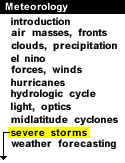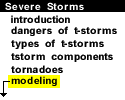
|
Severe storm modeling has provided forecasters with a useful learning tool -- forecast (or convective) matrices. These matrices serve to practically condense years of modeling research results and give forecasters quick access to relationships between environment and storm type.
A forecast matrix is built by making many simulations using different combinations of wind shear and CAPE that are representative of actual storm environments. Different storm behavior is observed in these different environments. The matrix shows these results to the forecaster in the form of low level and mid level radar signatures, cloud visualizations, wind patterns, and sometimes, a brief explanation. For example, below is a 3-D view of thunderstorms that develop in a high CAPE, high speed shear (no directional shear) environment.

The original source of this image is the Cooperative Program for Operational Meteorology, Education and Training (COMET®) of the University Corporation for Atmospheric Research. Copyright © 1996 University Corporation for Atmospheric Research. All Rights Reserved |
Forecasters always have estimates of wind shear and CAPE. With these, they can refer to the matrix and can get a first estimation about the potential for any developing storm to be severe.
Unfortunately, environments can change very quickly and once a storm develops, it can change its own environment. This means that the matrix is best used as a guide, and other factors -- observations, forecast models, spotters, and experience -- are vitally important.

introduction |
|

Parameters |





